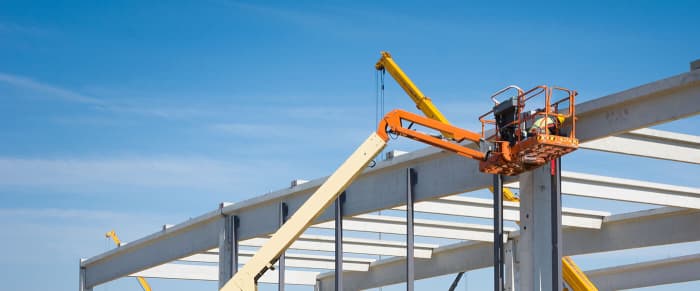Straight Boom Lift Rentals
Straight Boom Lift Rentals
Get pricing & availability from local rental companies:
Set Location for Rates
Set Location for Rates
Searching 12 Straight Boom Lift rental sizes across rental companies.
30 Ft, Electric (Indoor Use Only) Straight Boom Lift
Daily (National Average):
$445
40 Ft, Dual Fuel/Diesel Straight Boom Lift
Daily (National Average):
$420
45 Ft, Dual Fuel/Diesel Straight Boom Lift
Daily (National Average):
$464
60 Ft, Dual Fuel/Diesel Straight Boom Lift
Daily (National Average):
$586
65 Ft, Dual Fuel/Diesel Straight Boom Lift
Daily (National Average):
$586
 If it’s available, DOZR finds it.We search all suppliers near you to source your equipment on-time for the right price.How DOZR Sources Equipment
If it’s available, DOZR finds it.We search all suppliers near you to source your equipment on-time for the right price.How DOZR Sources Equipment Flexible cancellation.In case you need to cancel your order, let us know as soon as possible to avoid cancellation fees.Cancellation Policy
Flexible cancellation.In case you need to cancel your order, let us know as soon as possible to avoid cancellation fees.Cancellation Policy We deliver your equipment where you need it, when you need.Simply set your delivery preferences in checkout and our team will handle the logistics.Delivery & Transportation
We deliver your equipment where you need it, when you need.Simply set your delivery preferences in checkout and our team will handle the logistics.Delivery & Transportation Equipment service.Breakdowns happen; we get you repairs or replacements fast to minimize downtime. The DOZR Team is available Mon–Fri between 8am and 5pm EST for any and all...Learn More
Equipment service.Breakdowns happen; we get you repairs or replacements fast to minimize downtime. The DOZR Team is available Mon–Fri between 8am and 5pm EST for any and all...Learn More Control your rentals with ease.After your order is placed, you can easily access and manage the rental, like extending and off-renting, right from the confirmation email.Managing Your Rental
Control your rentals with ease.After your order is placed, you can easily access and manage the rental, like extending and off-renting, right from the confirmation email.Managing Your Rental Need attachments?Buckets, thumbs, forks, augers – simply specify what you need in Checkout and The DOZR Team will make it happen.Attachments & Requests
Need attachments?Buckets, thumbs, forks, augers – simply specify what you need in Checkout and The DOZR Team will make it happen.Attachments & Requests More Questions?Our FAQ has answers.
More Questions?Our FAQ has answers.
80 Ft, Dual Fuel/Diesel Straight Boom Lift
Daily (National Average):
$872
85 Ft, Dual Fuel/Diesel Straight Boom Lift
Daily (National Average):
$872
120 Ft, Dual Fuel/Diesel Straight Boom Lift
Daily (National Average):
$1,569
125 Ft, Dual Fuel/Diesel Straight Boom Lift
Daily (National Average):
$1,601
135 Ft, Dual Fuel/Diesel Straight Boom Lift
Daily (National Average):
$1,844
150 Ft, Dual Fuel/Diesel Straight Boom Lift
Daily (National Average):
$3,205
180 Ft, Dual Fuel/Diesel Straight Boom Lift
Daily (National Average):
$3,749
Recommended Straight Boom Lift Guides
The Ultimate Straight Boom Lift Spec Guide
For differentiating features and specs on Genie, JLG, Skyjack, Snorkel, MEC, and Haulotte ...
Straight Boom Lift Weight & Spec Comparison ChartThe 5 Best Boom Lift Attachments For Your Job Site
The most useful straight boom lift attachments and how they can help you work more efficie...
Boom Lift AttachmentsArticulating vs. Straight Boom Lifts: How To Pick the Right Boom Lift
Read about the main differences between articulating and straight/telescopic boom lifts!
Articulating vs straight boom lift comparisonComparing Electric Boom Lift Brands: Which Stands Out?
With several electric boom lift brands, it can be hard to pick the best one for your proje...
Compare The Best Straight Boom Lift BrandsSimilar Equipment
Learn More About Heavy Construction Equipment
Choosing an Aerial Lift: Which Man Lift is Best for the Job?
With so many different types and sizes of aerial lift, it can be hard to know which one to use for a job. Check out tips and tricks on how to choose which aerial lift is best for your job.
Read Article
Deck the Halls with a Rented Man Lift
When decorating for the holidays, it's important to prioritize safety. Learn more the different types of man lifts that can be used to decorate your home or building this holiday season.
Read Article
The Boom Lift: Everything You Need To Know
As some of the best aerial work platforms in the industry, boom lifts are on almost every construction site. Learn more about these man lifts, their sizes and specs, and manufacturers.
Read Article
Refund Policy
DOZR offers refunds within 24 hours if the equipment does not meet the specifications that were transacted on. Equipment rented on DOZR can be returned at any time by emailing equipment@dozr.com, and no further rental charges will be charged after the equipment is off-rented.
